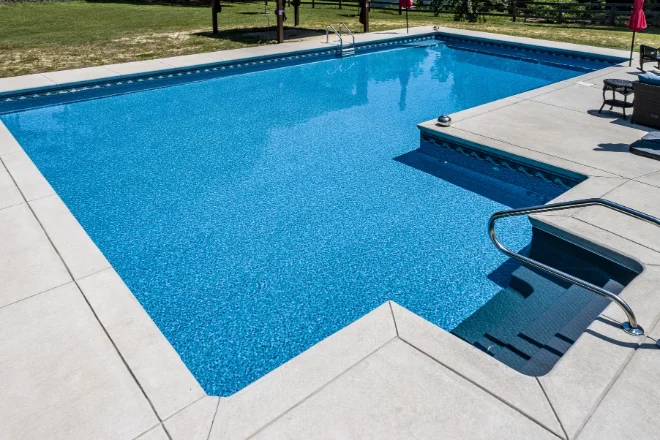
- Planning a pool involves more than just design — permits, site assessments, and timelines play a huge role.
- Custom design matches your pool to your lifestyle, climate, and property layout.
- Budgeting realistically includes base costs, hidden expenses, and long-term value.
- Features, tech, and proper maintenance help your pool stay beautiful and functional for years.

There’s something pretty magical about stepping into your backyard and seeing a pool built just for you. Not a cookie-cutter rectangle, not a prefab shape you had to settle for — but a pool designed around your lifestyle, space, and vision. That’s the beauty of going custom, especially with concrete. It gives you the freedom to dream big.
But, like any major project, creating a custom pool isn’t just about picking tiles and imagining cannonballs on a summer afternoon. A process behind it involves permits, planning, timelines, and a lot of decision-making. If you’re serious about turning that dream into a splash-worthy reality, it helps to know what’s ahead.
This guide walks you through the need-to-knows of planning a custom concrete pool. From laying the groundwork to choosing your design and budgeting smartly, we’ll ensure you’re ready to dive in confidently.
Understanding the Planning Process
So, where do you start when you want to build a pool from scratch? It might be tempting to jump straight into picking out tiles and sketching shapes, but trust us — it all begins with logistics.
First, there’s the legal stuff. Depending on where you live, you might need permits from your local council, approval from neighborhood associations, or a thumbs-up from zoning regulators. These rules cover how close your pool can be to property lines, how deep it can go, and even what kind of safety fencing you’ll need. It sounds dry, but it’s non-negotiable — and skipping this step can derail your project fast.
Next comes the site assessment. Your backyard might look pool-ready, but a professional must inspect the slope, soil type, drainage, and equipment access. If your lot is on a hill or has tricky soil (like clay or sandy patches), it can affect everything from the pool’s stability to the overall cost.
This is also when you should bring in a qualified pool builder or designer. A good pro won’t just take measurements — they’ll ask questions about how you plan to use the pool. Is it for laps? Family fun? Just to make your backyard look incredible? Those details influence every planning decision, from size to shape to placement.
The planning stage can take a few weeks to a couple of months, depending on your location, the complexity of the design, and how quickly permits are approved. It’s not the most glamorous part of the process, but it’s essential to get right.
Why Design Choices Matter More Than You Think
Once the technical groundwork is done, you focus on the fun part—design. This is where your pool starts to feel real. But good design involves more than just picking a shape or a pretty tile.
The best custom pools are built around how you’ll use them. Want a lap lane for morning swims? A shallow ledge for kids? A built-in spa for winding down at night? These aren’t just add-ons — they’re part of your lifestyle and should shape your design.
And don’t forget the aesthetic. A well-designed pool doesn’t just sit in your backyard — it becomes the focal point. With concrete, you’re not locked into standard shapes or sizes, which opens the door for infinity edges, beach entries, or sleek geometric layouts that blend with modern landscaping.
When exploring custom concrete pool designs, working with a local professional makes a real difference. They’ll understand how your regional climate, soil type, and even sunlight patterns affect everything from durability to water temperature. Plus, they’ll help translate your ideas into something beautiful and buildable, because not every Pinterest pool works in every backyard.
In short, design isn’t just about looks—it’s about creating a space that seamlessly integrates with your life and home.
Budgeting with Eyes Wide Open
Let’s be real — building a custom concrete pool is a significant investment. But the key word here is investment. It’s not just about the upfront price tag; it’s about value over time. That said, it helps to go in with a solid understanding of what your budget is covering — and where those sneaky hidden costs like to hide.
The cost of a concrete pool can vary wildly depending on size, finishes, added features, and where you live. On average, you’re looking at a starting point somewhere around $50,000, but that number can climb quickly. Want a built-in spa? Expect a bump. Fancy mosaic tile and high-end lighting? Add another bump. These are choices worth making if they’ll enhance your lifestyle, but they should be factored in early.
Then there’s site prep — the not-so-fun stuff that can quietly consume a chunk of your budget. Things like grading uneven land, reinforcing retaining walls, or managing groundwater aren’t glamorous, but they’re critical to ensuring your pool lasts. And don’t forget about the extras like landscaping, fencing, or decking, which often come after the pool is built but can significantly add to the overall cost.
What trips people up most isn’t the base price — it’s the surprises. That’s why working with a transparent contractor who provides detailed breakdowns can save you headaches (and money). They’ll help you prioritize what matters most, what’s nice to have, and what you can add later.
Long story short: plan for more than the quote you see on paper. Consider your budget as a roadmap that balances today’s cost with tomorrow’s enjoyment.
Timelines and What to Expect During Construction
If you’ve never lived through a backyard construction project, here’s your heads-up: it’s not a quick weekend makeover. Building a concrete pool takes time, not just because of the construction itself, but everything leading up to it.
From the day your permit is approved to when you’re swimming laps, you’re probably looking at a timeframe of 8 to 12 weeks. And that’s if things go smoothly. Weather delays, material shortages, and scheduling conflicts can stretch things out a bit, especially during peak building season.
Construction typically begins with excavation—that’s the digging stage, and it can look pretty chaotic at first. Next comes forming and framing, where your pool’s shape starts to take shape. After that, plumbing and electrical work are installed before the concrete is poured. Once the shell is in place and cured (which takes a little time), the finishing touches are added—tiling, plastering, and additional features like waterfalls or lighting.
Throughout all this, your backyard will look like a construction zone. There’ll be noise, dust, and lots of foot traffic. Preparing for some disruptions is a good idea if you’re living at home during the build. But hey, it’s temporary — and the reward is a one-of-a-kind pool you’ll enjoy for years.
Communication is key during this phase. A good builder will update you on progress, delays, and next steps. Don’t be afraid to ask questions or request updates — it’s your project, and you should feel confident every step.
Features That Make Your Pool Stand Out
Once the structure is in place, it’s time to have fun. This is when your pool starts to feel like yours, with design details and add-ons that elevate it from “nice” to “unforgettable.”
One of the most popular upgrades these days is tanning ledges. These shallow platforms are perfect for lounging in a few inches of water with a book or a drink in hand. They add a resort vibe and are great for little kids or pets who want to splash without diving in.
Then there’s lighting — something that’s easy to overlook but makes a massive difference. Underwater LED lights can be customized by color and brightness, turning your nighttime swim into a full-on mood. Want a little extra drama? Add water features like deck jets, rain curtains, or a bubbling spa spilling into the pool.
Smart pool tech is also making waves (pun intended). You can control lighting, temperature, cleaning systems, and water features straight from your phone. So if you’re the type who loves a bit of convenience with your luxury, it’s worth considering automation from the start.
Remember that everything around your pool is connected. The surrounding deck, landscaping, seating, and shade structures all help create an experience—not just a place to swim. The best pools are designed as part of a bigger backyard vision.
Maintenance and Long-Term Care Considerations
Here’s the thing: concrete pools are built to last — but only if you’re willing to show them some love over the years. While they’re incredibly durable, they do need a little more upkeep than, say, fiberglass pools.
For starters, the interior surface will need resurfacing every 10 to 15 years, depending on the materials used and how well you maintain it. Brushing the walls regularly helps prevent algae buildup, and keeping the water chemistry balanced protects the pool and its equipment.
Routine maintenance includes cleaning filters, checking pumps, and skimming leaves and debris. If you’re hands-on, you can do this yourself, but many pool owners opt for a maintenance service, especially if they have a busy schedule.
Another thing to note: seasonal care matters. You must winterize your pool properly to avoid damage if you live somewhere with freezing winters. On the flip side, if you’re in a warm climate year-round, you’ll want to stay on top of algae control during those peak summer months.
Think of maintenance as part of the long game. A little consistency now keeps your pool looking sharp, working well, and staying safe for everyone who uses it. Plus, it protects your investment, because no one wants to deal with costly repairs that could’ve been avoided.
Conclusion
Building a pool isn’t just about putting water in the ground — it’s about creating a space where memories are made. Whether it’s quiet morning swims, weekend parties with friends, or simply watching the water reflect the evening sky, the payoff for thoughtful planning is huge.
By understanding what goes into the process, making informed choices, and partnering with the right professionals, you can turn that sketch into something you’ll enjoy for years to come.
Take your time, ask the right questions, and design a pool that fits your lifestyle. When done right, a pool isn’t just a luxury—it’s a lifestyle upgrade.
Keep an eye for more latest news & updates on Buzz Feed!




